The Nexus 7 (2013) Review
by Anand Lal Shimpi on August 22, 2013 6:00 PM ESTCPU Performance
The while the original Nexus 7 was fast for the money, the new Nexus 7 is just fast. Moving away from NVIDIA to Qualcomm, ASUS and Google settled on the APQ8064 Pro. Although we originally assumed this would be a quad-core Krait 200 based SoC, Brian's teardown revealed the part number 8064-1AA. What's special about that part number is it implies newer Krait 300 cores, making the SoC effectively a Snapdragon 600.
The CPU cores can run at up to 1.5GHz, putting it a bit lower than what we've seen from Snapdragon 600 based phones (e.g. HTC One tops out at 1.7GHz, while the US SGS4 hits 1.9GHz).
I was curious as to the impact of the lower frequency when combined with the potentially higher chassis TDP so I compared the Nexus 7 to the US Galaxy S 4. I turned to Geekbench because it offers a nicely woven mixture of single and multithreaded benchmarks, letting me look at peak available single core performance as well as what happens when multiple cores are active and working.
In this first graph we're looking at the first Krait 300 core running the workload. I've zoomed in to a small portion of the benchmark so we can get a better idea of CPU behavior:
The Nexus 7's CPU0 is almost always pegged at 1.5GHz whereas we see a lot of bursty thermal management on the smaller SGS4. This isn't unexpected, but what ends up happening is the sustained performance advantage drops from a peak theoretical max of 26% down to a more reasonable average gain of ~8%.
I was curious to see if multithreaded workloads showed any different behavior. Here we're looking at the fourth CPU core (CPU3). Note that it's not always active, which is why you see parts of the graph drop down to 0KHz. Once again we see similarly static behavior from the Nexus 7. Even with all four cores active, when you need the performance the Nexus 7 delivers a full 1.5GHz. These tests are short enough where we don't see tremendous swings in frequency, but once again we do see some frequency modulation in a smaller chassis.
The end result is that the Nexus 7's 1.5GHz Krait 300 cores are slower than what you'd get in a Galaxy S 4, however the gap isn't nearly as large as you'd expect it to be thanks to the larger chassis and how the platform is tuned. The Nexus 7 can run at 1.5GHz more consistently than Snapdragon 600 based phones can run at 1.7/1.9GHz.
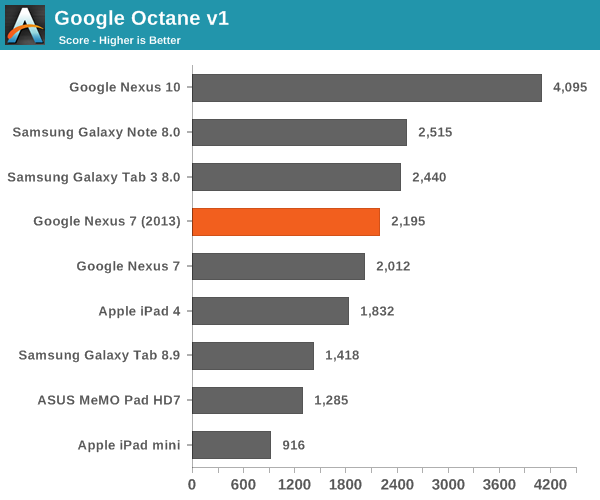


The GPU
Qualcomm seems to be frequency binning here, which is standard industry practice. Using binning to create these different SKUs gives Qualcomm pricing flexibility and also gives it the option to give large customers special treatment.
On the graphics side Qualcomm's Adreno 320 GPU makes an appearance. Clock speeds are also limited to 400MHz, compared to 450MHz for the high-end Snapdragon 600 implementations we've seen.
The APQ8064-1AA's dual-channel memory controller is populated with four x 16-bit DDR3L-1600 memory devices, giving the Nexus 7 a healthy amount of memory bandwidth. Peak memory bandwidth available to the APQ8064-1AA is 12.8GB/s, equalling what's available to Apple's A5X in the 3rd generation iPad with Retina display. Tons of memory bandwidth is obviously a pre-requisite for driving a high resolution display, and the combination of DDR3L-1600 and the Adreno 320 GPU delivers a butter smooth UI in all well written Android apps.
Although CPU performance is somewhat middle of the road compared to the rest of the landscape, GPU performance is faster than any other Nexus device on the market - and pretty much faster than any other similarly sized tablet:
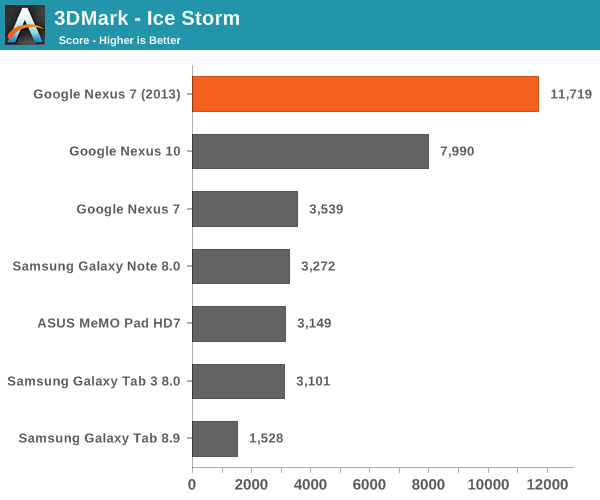
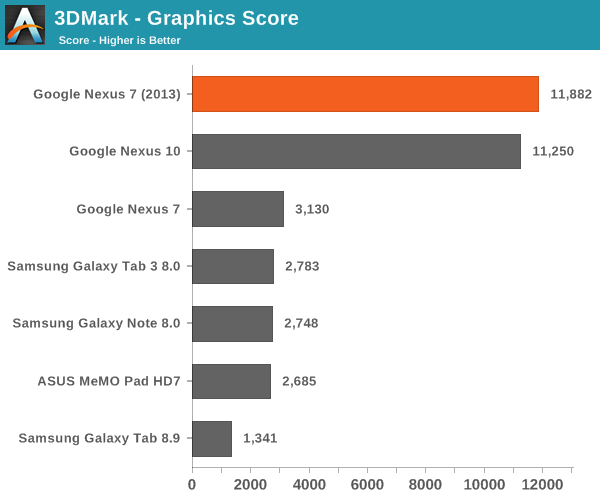
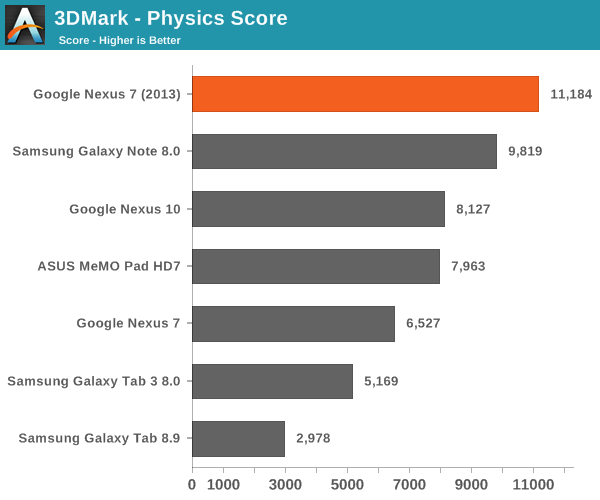
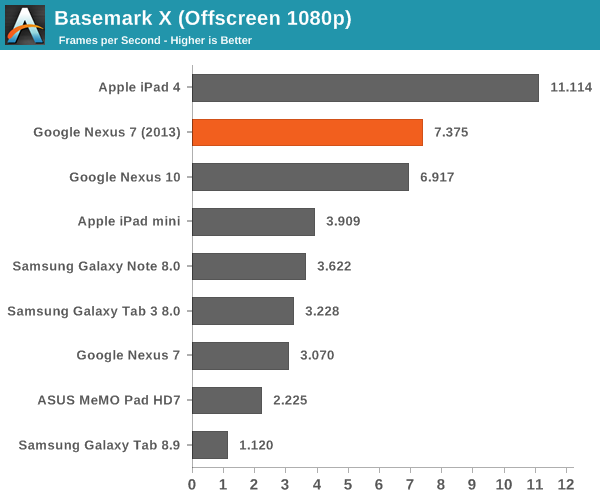
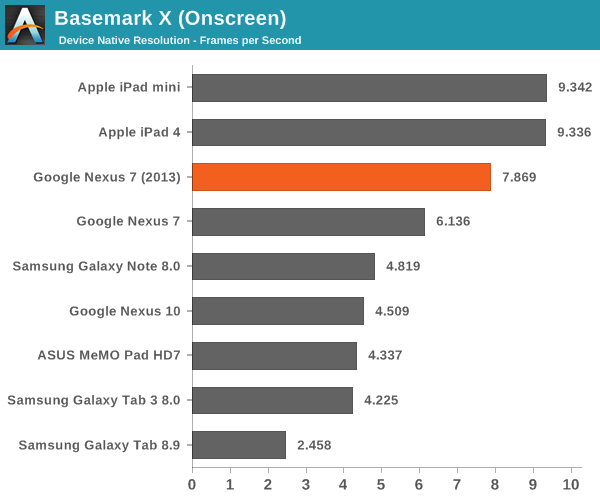
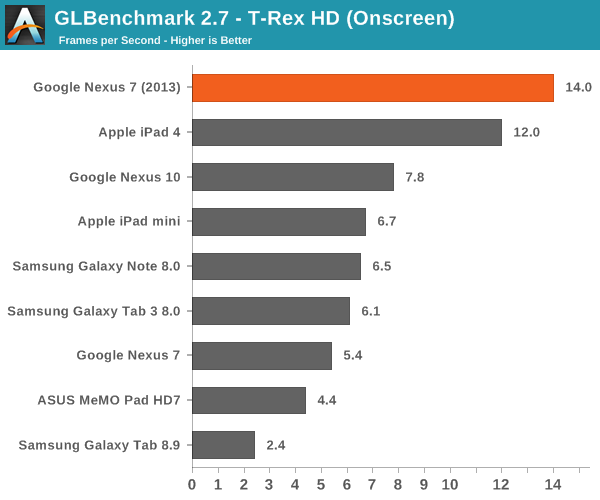
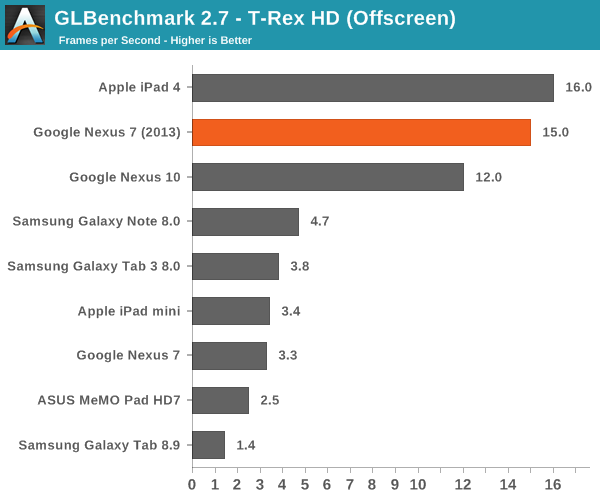
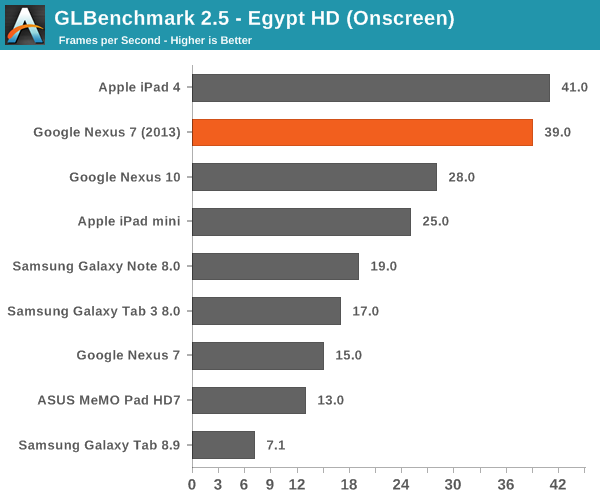
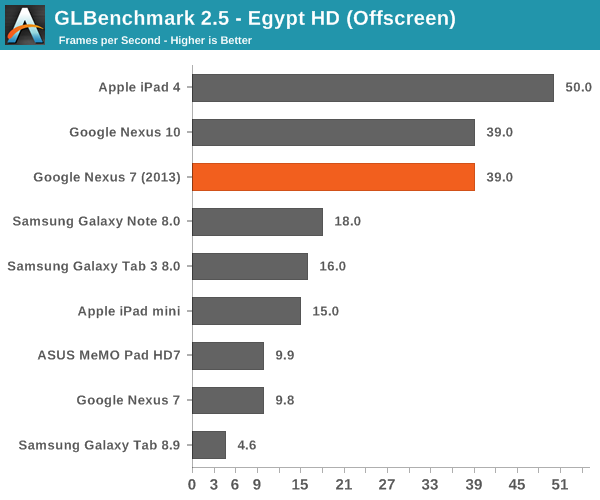
I played Modern Combat 4 as well as Shadowgun, both demanding 3D titles, on the new Nexus 7. Both titles appeared to render at the Nexus 7's native 1920 x 1200 resolution, and both appeared to do so at around 30 fps.


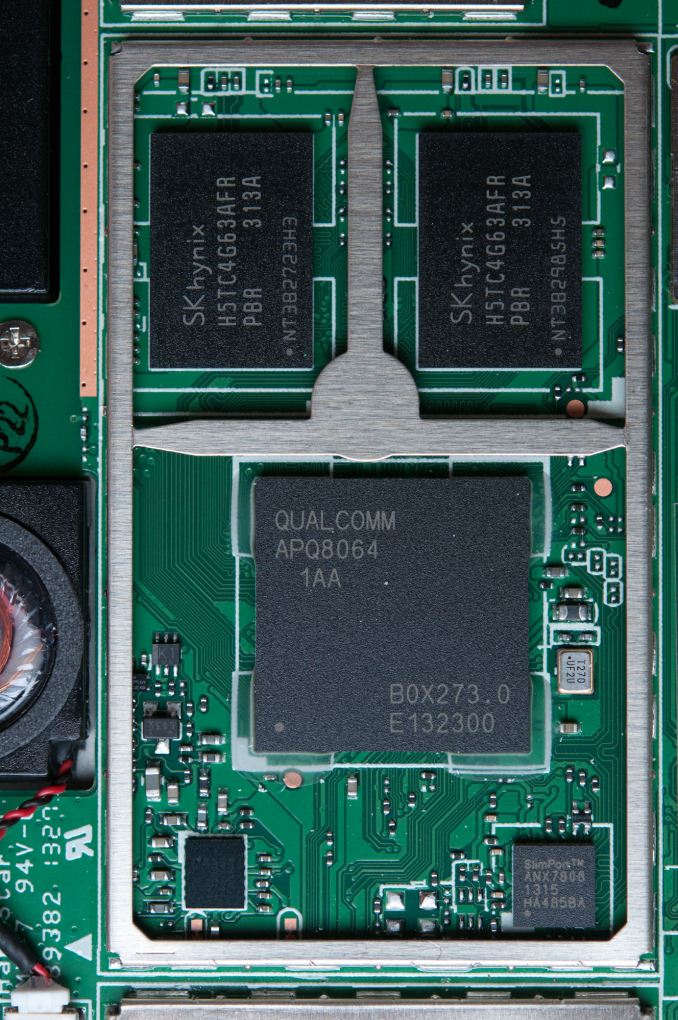
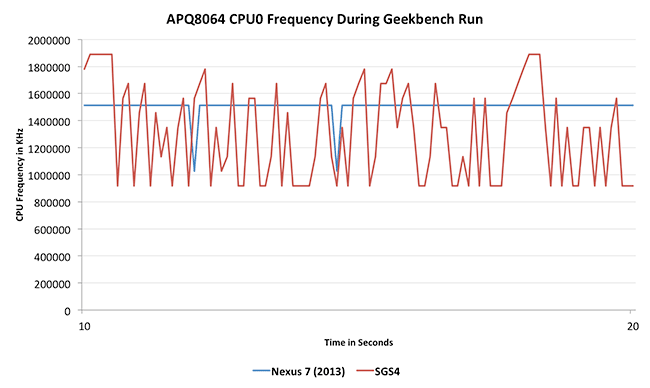
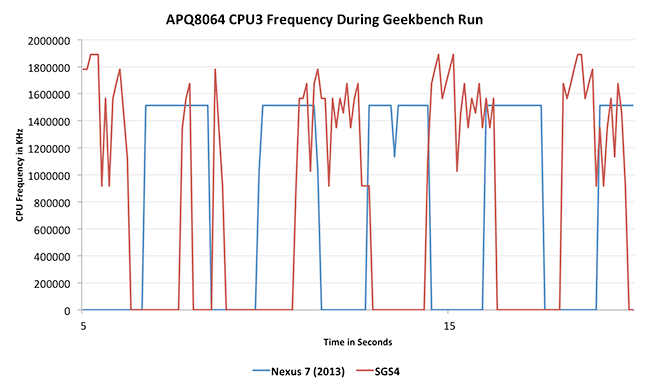








202 Comments
View All Comments
solipsism - Thursday, August 22, 2013 - link
With the Amazon Kindle Fire having the same size display, aspect ratio, running Android (even if it is a more limited version of it), and being at the same $199 price point I wonder why the Kindle Fire isn't compared directly with the Nexus 7.jeffkibuule - Thursday, August 22, 2013 - link
Because it's a more limited version of Android, and software really is everything. Unless you are really into Amazon's ecosystem or just absolutely love hacking software onto hardware, the Kindle Fire isn't a device that should be recommended over the Nexus 7 (2013).hugh2323 - Thursday, August 22, 2013 - link
Have you even used a Kindle Fire? They are so locked into Amazon they are useless as a general purpose tablet. And hacking them is not easy, if possible at all with newer models.BigLan - Thursday, August 22, 2013 - link
I've had the GPS problem on 2 units now - took the first one back which wouldn't last more than 5 minutes without loosing a lock.I've avoided using the google maps/nav app which seems to have worked. I had one gps drop for the first 2 weeks (after copilot crashed) but after update Maps the other day the issues started up again. I uninstalled the update and disabled Maps and it seems to be working again.
I know this is just an anecdote, but maybe it'll work for someone else.
BigLan - Thursday, August 22, 2013 - link
I think that's because Anand is one of the few sites that test at a standard brightness. Most of the other reviews will just use a standard % like 50% which on the new N7 is the same as running the 2012 model at 90% brighness.I haven't seen battery life as long as Anand's numbers though, even using auto brightness which seems like 30-50%, but I do use the gps and play some games which will impact battery life.
It'd be nice to see an idle battery life test as I've seen people complaining about the device losing 10% of the charge daily when unplugged. I know that's be harder (and take much longer) to test, but I've noticed that my adroid devices do drain faster than ios ones do.
teiglin - Thursday, August 22, 2013 - link
You don't need to remind Anandtech readers why brightness-calibrated battery tests are the only reasonable way to test battery life. Percentage tests crack me up every time I see them.I'd also be interested in seeing some sort of idle test, but the things that cause battery to drain while in "standby" are very hard to pin down. Fully power-gated current draw is going to be basically zero for any modern SoC, so that's not really at issue--what causes idle drain is things that wake the device, but usage varies so much that you could argue the issue is not testable--most people probably use push email, so how many emails do you get in a day? Some people may only get half a dozen, while others get hundreds or even more. Do you use Google Now and its location-seeking wakes? Do you let your social networking clients check all the time (some default to ridiculous levels like automatically checking every 15 minutes)?
That doesn't even take into account smaller concerns like signal strength and bluetooth devices--my thoroughly unscientific testing puts the former at around a 1%/hr swing on my phone, while the latter can drain nearly 2%/hr despite being in deep sleep the whole time. I consider "good" idle drain on my phone to be under 1%/hr, though realistically I'm usually a bit higher than that.
That's not to say the issue isn't worth investigating--I'd love to see testing using Brian's base station emulator, and a regular interval for waking with fixed workload at each wake--say, wake every 10 minutes, scan wifi/cellular for location, and receive 1MB of data, or something--but the fact remains that individual circumstances are going to be the absolutely dominant factor in any idle scenario.
As a final note to your iOS comparison, iOS obviously has the advantage of tight controls over how apps can wake the device, so most people will have fewer issues with rogue apps causing high idle drain. Combined with the lack of aggressive Google Now location services, it's not hard to see why iOS tends to do better on battery than Android.
jeffkibuule - Thursday, August 22, 2013 - link
Brian Klug recently stated that an app like Reddit HD, a very popular Reddit client on Android, mindlessly checks for new messages every 15 minutes. That's incredibly wasteful and one of several reasons why Android battery life numbers can easily be all over the place depending on what you have installed.teiglin - Thursday, August 22, 2013 - link
Exactly, dumb apps like that are why the plebs think android has bad battery life. It's unhelpful to said plebs to say "it's not Android's fault" since it is, as far as they know/care, but imo, if you have standby time issues but can't/won't use BetterBatteryStats or similar to determine why, then you're probably better off getting an iPhone (or Windows Phone, if that's your cup of tea).Impulses - Friday, August 23, 2013 - link
That's totally accurate and yet a lot of people would take offense at it... Android gives you a bit more freedom, which is great for some, but it's just more rope to hang yourself with for others. I think both OS approaches have plenty of merit in this world.sprockkets - Thursday, August 22, 2013 - link
ever going to review the nexus 10?